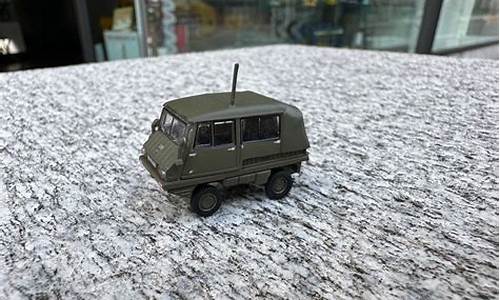haflinger音标_Haflinger
1.一辆Pinzgauer多少钱
2.法语中有哪些缩写?
3.英语作文关于克隆的相关句子和单词?
4.真硬汉敢去野,带你体验“爷爷辈”的奔驰G级
5.哈福林格马的缺点

1965年,斯太尔-戴姆勒-普赫公司在Haflinger越野车的基础上开发出载重量为1吨的新型越野车,于11年正式投产, 并改名Pinzgauer。斯太尔公司在越野车设计上很有自己的特色,Pinzgauer越野车不仅设计理念源自Haflinger越野车,连结构、外型都和Haflinger越野车十分相像,基本上就是Haflinger越野车的放大版,只是发动机从车尾移到了车头。11年,Pinzgauer越野车正式投产,30多年来,在这个基础上斯太尔公司只是不断地改进发动机和变速箱,而其它设计,如中央管状车架及悬挂系统都基本不变。
70年代,Pinzgauer越野车的同期对手是英国的Land Rover FC101和瑞典的VOLVO 4140越野车,由于FC 101和VOLVO 4140越野车都同时开发了6X6越野车,为加强竞争力,斯太尔公司也推出了自己的6x6越野车,以加大载重量及提高越野性能,使Pinzgauer越野车形成了4X4、6X6两个系列。
平茨高尔。很奇怪的名字!但是确实是好东西。它有4*4和6*6两种版本。从外形来看,该车线条棱角分明,猪鼻式的车头极像前苏联或东欧集团的设计,但它是奥地利斯太尔-戴姆勒-普赫公司生产。越野车中能同它相比的只有奔驰Unimog越野车,但二者不是同一级别的车,吨位相差十分大,Pinzgauer只是一吨级的越野车。
除了中央管状车架保护传动装置外,车头前端也有钢制护板。 发动机安装在车厢内,动力由Z式驱动系统从管外走进管内,除了方便维修外,还可以最大限度增加车底净高,增强通行性。车桥与车轮间用drop.Gear(低一级齿轮)设计,使离地间隙高达335mm。 中央脊梁独立悬挂全动驱动。这样的驱动方式除了在这里,只能在太脱拉身上能够看到,实在是不容易,也只有这样才能保证最高级别的悬挂驱动能力。 用了全合金的中央管状车架。传动系统内藏于管状车架内。驱动系统得到全防水密封保护。这种结构的成本高,但可靠性也高,只是对机械加工的工艺要求极高,因此也只有奥地利、德国等机械加工水平较高的国家才能保证其结构的可靠性。
一辆Pinzgauer多少钱
“斑马”的英语:zebra,读音:[?zebr?]。
zebra
英 [?zebr?] ? 美 [?zibr?] ?
n.斑马。
adj.有斑纹的。
短语
1、Leptobotia zebra 斑纹薄鳅
2、Zebra Mbuna 斑马拟丽鱼
3、Aplochiton zebra 条纹单甲南乳鱼
4、Zebrias zebra 条鳎
5、Zebra jasper 斑纹碧石
例句:
The?most?famous?of?these?gifts?were?a?giraffe?and?a?zebra.?
这些礼物中最著名的是一只长颈鹿和一只斑马。
扩展资料:
zebra的词汇搭配:
1、zebra color tube 斑纹彩色显像管...。
2、zebra roof 斑马状炉顶,联合式屋...。
3、zebra tube 斑纹彩色显象管...。
4、zebra butterfly 白带纲纹蛱蝶。
5、zebra danio 斑马鱼。
其他种类马的英文:
1、乘用小型马 Riding Pony
2、柯柏马 Cob ?
3、马球小型马 Polo Pony ?
4、冰岛马 Icelandic Horse?
5、挪威峡湾马 Fjord ?
6、哥德兰马 Gotland
7、胡克尔马 Hucul
8、柯尼克马 Konik
9、哈菲林克尔马 Haflinger
10、阿列日马 Ariegeois
11、兰道斯马 Landais ?
12、波特克马 Pottock
法语中有哪些缩写?
施泰尔-戴姆勒-普贺 匹兹高尔 STEYR-DAIMLER-PUCH PINZGAUER 从某种意义上讲,小个的HAFLINGER是最能干的4X4了,这种奥地利施泰尔-戴姆勒-普贺生产的车辆和其他所有的4X4生产厂家走了相反的路,他们将这种车生产的尽量小尽量轻,并运用了很多可以使用的最好的4X4技术 生产主要为了能把四个奥地利士兵运上高山---任何高山,HAFLINGER能去几乎任何地方。 这种车很小,四个人足以把它抬起来,这其实有助于陷车后的自救,它的轴距只有1。37米,车宽1。5米,一台646CC的双缸风冷汽油机,很高的离地间隙和驶入及离去角,配上坚固的变速箱,带前后桥差速器锁—意味这如果只有一只车轮着地,它也能继续行驶。 HAFLINGER生产于58年到74年,后来被更强劲的PINZGAUER代替—非常相似但更大。 PINZGAUER有4X4和6X6两种,可以搭载1。5吨以上货物,非常坚固,制造质量也极高,并且它可以处理几乎任何露况,柔性车架是它们成功的秘密之一。 让路虎车迷们无比气恼的是,英国军队使用的路虎正被这种车辆逐步淘汰。 前期车型安装的是2。5升4缸风冷发动机,后期用大众公司的2。4升6缸水冷增压柴油机,从2002起,一种大众欧三标准的2。5升5缸增压中冷柴油机的变形机种开始在PINZGAUER上使用,实地测试这种新发动机在车辆满载时的速度及动力甚至超出上款车型空载状态。 PINZGAUER目前正处于最高产量期,2000年6月,生产和设计已授权给一家英国私人公司AUTOMOTIVE TECHNIK,并为英国军队和世界各地提供PINZGAUER。 PINZGAUER比UNIMOG小一些轻一些,但和UNIMOG一样动力强劲,道路速度更快,并拥有同样的越野性能。
英语作文关于克隆的相关句子和单词?
la heure 写成 l'heure 更准确地说应该叫连诵,“缩写”通常指的是比如:CCTV就是China central television的缩写,ONU则是Organisme des Nations unies(联合国的法语说法)的缩写。
所以如果你想知道有哪些缩写,那法语中简直太多了,法国人超喜欢把各种成为缩写来简化书写。
我估计你是想知道法语中哪些元音或者哑音h开头的单词,能够让冠词le或者la与之连写。
法语中凡是以a/e/o/u等等元音开头的单词和哑音h开头的单词都符合上述规则,常见的哑音h单词有habille(穿),hier(昨天),humeur(幽默),huit(八),histoire(历史)
hiver(冬天),honneur(荣誉),heure(小时)等。而像hauteur, hache 等嘘音h开头的单词则不能与le la连诵。这类单词有很多,遇到的时候记一下就行。
参考嘘音h开头的部分单词:
h?blerie
h?bleur/euse
hachage
hache
haché/e
hache-viande
hache-légumes
hache-paille
hachement
hacher
hachette
hacheur
hachis
hachisch
hachoir
hachure
hachurer
hackle
hadal/e/aux
haddock
haflinger
hafnium
hagard
haggis
haie
haillon
haillonneux/euse
haine
haineusement
haineux/euse
ha?r
haire
ha?ssable
Ha?tien/enne
halage
h?lage
halal
真硬汉敢去野,带你体验“爷爷辈”的奔驰G级
Cloning in biology is the process of producing populations of genetically-identical individuals that occurs in nature when organisms such as bacteria, insects or plants reproduce aually. Cloning in biotechnology refers to processes used to create copies of DNA fragments (molecular cloning), cells (cell cloning), or organisms. More generally, the term refers to the production of multiple copies of a product such as digital media or software.
Molecular cloning refers to the process of making multiple copies of a defined DNA sequence. Cloning is frequently used to amplify DNA fragments containing whole genes, but it can also be used to amplify any DNA sequence such as promoters, non-coding sequences and randomly fragmented DNA. It is used in a wide array of biological experiments and practical lications ranging from genetic fingerprinting to large scale protein production. Occasionally, the term cloning is misleadingly used to refer to the identification of the chromosomal location of a gene associated with a particular phenotype of interest, such as in positional cloning. In practice, localization of the gene to a chromosome or genomic region does not necessarily enable one to isolate or amplify the relevant genomic sequence.
In practice, in order to amplify any DNA sequence in a living organism, that sequence must be linked to an origin of replication, which is a sequence of DNA capable of directing the propagation of itself and any linked sequence. However, a number of other features are needed and a variety of specialised cloning vectors (small piece of DNA into which a foreign DNA fragment can be inserted) exist that allow protein expression, tagging, single stranded RNA and DNA production and a host of other manipulations.
Cloning of any DNA fragment essentially involves four steps [1]
fragmentation - breaking apart a strand of DNA
ligation - gluing together pieces of DNA in a desired sequence
transfection - inserting the newly formed pieces of DNA into cells
screening/selection - selecting out the cells that were successfully transfected with the new DNA
Although these steps are invariable among cloning procedures a number of alternative routes can be selected, these are summarized as a cloning strategy’.
Initially, the DNA of interest needs to be isolated to provide a DNA segment of suitable size. Subsequently, a ligation procedure is used where the amplified fragment is inserted into a vector (piece of DNA). The vector (which is frequently circular) is linearised using restriction enzymes, and incubated with the fragment of interest under ropriate conditions with an enzyme called DNA ligase. Following ligation the vector with the insert of interest is transfected into cells. A number of alternative techniques are ailable, such as chemical sensitivation of cells, electroporation and biolistics. Finally, the transfected cells are cultured. As the aforementioned procedures are of particularly low efficiency, there is a need to identify the cells that he been successfully transfected with the vector construct containing the desired insertion sequence in the required orientation. Modern cloning vectors include selectable antibiotic resistance markers, which allow only cells in which the vector has been transfected, to grow. Additionally, the cloning vectors may contain colour selection markers which provide blue/white screening (α-factor complementation) on X-gal medium. Nevertheless, these selection steps do not absolutely guarantee that the DNA insert is present in the cells oained. Further investigation of the resulting colonies is required to confirm that cloning was successful. This may be accomplished by means of PCR, restriction fragment analysis and/or DNA sequencing.
Cloning a cell means to derive a population of cells from a single cell. In the case of unicellular organisms such as bacteria and yeast, this process is remarkably simple and essentially only requires the inoculation of the ropriate medium. However, in the case of cell cultures from multi-cellular organisms, cell cloning is an arduous task as these cells will not readily grow in standard media.
A useful tissue culture technique used to clone distinct lineages of cell lines involves the use of cloning rings (cylinders)[2]. According to this technique, a single-cell suspension of cells which he been exposed to a mutagenic agent or drug used to drive selection is plated at high dilution to create isolated colonies; each arising from a single and potentially clonally distinct cell. At an early growth stage when colonies consist of only a few of cells, sterile polystyrene rings (cloning rings), which he been dipped in grease are placed over an individual colony and a small amount of trypsin is added. Cloned cells are collected from inside the ring and transferred to a new vessel for further growth.
Cloning in stem cell research
Main article: Somatic cell nuclear transfer
Somatic cell nuclear transfer can also be used to create a clonal embryo. The most likely purpose for this is to produce embryos for use in research, particularly stem cell research. This process is also called "research cloning" or "therapeutic cloning." The goal is not to create cloned human beings, but rather to harvest stem cells that can be used to study human development and to potentially treat disease. While a clonal human blastocyst has been created, stem cell lines are yet to be isolated from a clonal source.[3]
Horticultural
The term clone is used in horticulture to mean all descendants of a single plant, produced by vegetative reproduction or apomixis. Many horticultural plant cultivars are clones, hing been derived from a single individual, multiplied by some process other than ual reproduction. As an example, some European cultivars of grapes represent clones that he been propagated for over two millennia. Other examples are potato and banana. Grafting can be regarded as cloning, since all the shoots and branches coming from the graft are genetically a clone of a single individual, but this particular kind of cloning has not come under ethical scrutiny and is generally treated as an entirely different kind of operation.
Many trees, shrubs, vines, ferns and other herbaceous perennials form clonal colonies. Parts of a large clonal colony often become detached from the parent, termed fragmentation, to form separate individuals. Some plants also form seeds aually, termed apomixis, e.g. dandelion.
Parthenogenesis
Clonal derivation exists in nature in some animal species and is referred to as parthenogenesis (reproduction of an organism by itself without a mate). An example is the "Little Fire Ant" (Wasmannia auropunctata), which is native to Central and South America but has spread throughout many tropical environments.
Reproductive cloning
Reproductive cloning uses "somatic cell nuclear transfer" (SCNT) to create animals that are genetically identical. This process entails the transfer of a nucleus from a donor adult cell (somatic cell) to an egg which has no nucleus. If the egg begins to divide normally it is transferred into the uterus of the surrogate mother.
Such clones are not strictly identical since the somatic cells may contain mutations in their nuclear DNA. Additionally, the mitochondria in the cytoplasm also contains DNA and during SCNT this DNA is wholly from the donor egg, thus the mitochondrial genome is not the same as that of the nucleus donor cell from which it was produced. This may he important implications for cross-species nuclear transfer in which nuclear-mitochondrial incompatibilities may lead to death.
Dolly the Sheep
Main article: Dolly the Sheep
Dolly (1996-07-05 – 2003-02-14), a Finn Dorsett ewe, was the first mammal to he been successfully cloned from an adult cell, though the first actual thing to be cloned, was a tadpole in 1952[1]. She was cloned at the Roslin Institute in Scotland and lived there until her death when she was six. On 2003-04-09 her stuffed remains were placed at Edinburgh's Royal Museum, part of the National Museums of Scotland.
Dolly was publicly significant because the effort showed that the genetic material from a specific adult cell, programmed to express only a distinct subset of its genes, could be reprogrammed to grow an entire new organism. Before this demonstration, there was no proof for the widely spread hypothesis that differentiated animal cells can give rise to entire new organisms.
Cloning Dolly the sheep had a low success rate per fertilized egg; she was born after 277 eggs were used to create 29 embryos, which only produced three lambs at birth, only one of which lived. Seventy calves he been created from 9,000 attempts and one third of them died young; Prometea took 328 attempts. Notably, although the first clones were frogs, no adult cloned frog has yet been produced from a somatic adult nucleus donor cell.
There were early claims that Dolly the Sheep had pathologies resembling accelerated aging. Scientists speculated that Dolly's death in 2003 was related to the shortening of telomeres, DNA-protein complexes that protect the end of linear chromosomes. However, other researchers, including Ian Wilmut who led the team that successfully cloned Dolly, argue that Dolly's early death due to respiratory infection was unrelated to deficiencies with the cloning process.
Species cloned
Further information: List of animals that he been cloned
The modern cloning techniques involving nuclear transfer he been successfully performed on several species. Landmark experiments[clarify] in chronological order:
Tadpole: (1952) Many scientists questioned whether cloning had actually occurred and unpublished experiments by other labs were not able to reproduce the reported results.[citation needed]
Carp: (1963) In China, embryologist Tong Dizhou cloned a fish. He published the findings in a Chinese science journal which was never translated into English.[4]
Mice: (1986) was the first successfully cloned mammal; Soviet scientists Chaylakhyan, Veprencev, Sviridova, Nikitin had mice "Masha" cloned. Research was published in the magazine "Biofizika" volume ХХХII, issue 5 of 1987.[clarify][5]
Sheep: (1996) From early embryonic cells by S Willadsen. Megan and Morag[citation needed] cloned from differentiated embryonic cells in June 1995 and Dolly the sheep from a somatic cell in 19.[6]
Human: (November 1998) hybrid embryo created from leg cells and a cleaned cow egg - not allowed to implant in a womb, nor develop, nor be born due to ethical issues.[citation needed]
Rhesus Monkey: Tetra (female, January 2000) from embryo splitting[7][clarify]
Gaur: (2001) was the first endangered species cloned.[8]
Cattle: Alpha and Beta (males, 2001) and (2005) Brazil[9]
Cat: CopyCat "CC" (female, late 2001), Little Nicky, 2004, was the first cat cloned for commercial reasons[citation needed]
Mule: Idaho Gem, a john mule born 4 May 2003, was the first horse-family clone.[citation needed]
Horse: Prometea, a Haflinger female born 28 May 2003, was the first horse clone.[citation needed]
Human cloning
Main article: Human cloning
Human cloning is the creation of a genetically identical copy of an existing or previously existing human. The term is generally used to refer to artificial human cloning; human clones in the form of identical twins are commonplace, with their cloning occurring during the natural process of reproduction. There are two commonly discussed types of human cloning: therapeutic cloning and reproductive cloning. Therapeutic cloning involves cloning cells from an adult for use in medicine and is an active area of research: while reproductive cloning would involve making cloned human beings. Such reproductive cloning has not been performed and is illegal in many countries. A third type of cloning called replacement cloning is a theoretical possibility, and would be a combination of therapeutic and reproductive cloning. Replacement cloning would entail the replacement of an extensively damaged, failed, or failing body through cloning followed by whole or partial brain transplant.
The various forms of human cloning are controversial.[10] There he been numerous demands for all progress in the human cloning field to be halted. Some people and groups oppose therapeutic cloning, but most scientific, al and religious organizations oppose reproductive cloning. The American Association for the Advancement of Science (AAAS) and other scientific organizations he made public statements suggesting that human reproductive cloning be banned until safety issues are resolved [11]. Serious ethical concerns he been raised by the idea that it might be possible in the future to harvest organs from clones. Some people he considered the idea of growing organs separately from a human organism - in doing this, a new organ supply could be established without the moral implications of harvesting them from humans. Research is also being done on the idea of growing organs that are biologically acceptable to the human body inside of other organisms, such as pigs or cows, then transplanting them to humans, a form of xenotransplantation.
The first human hybrid human clone was created in November 1998, by American Cell Technologies.[12]. It was created from a man's leg cell, and a cow's egg whose DNA was removed. It was destroyed after 12 days. Since a normal embryo implants at 14 days, Dr Robert Lanza, ACT's director of tissue engineering, told the Daily Mail newspaper that the embryo could not be seen as a person before 14 days. While making an embryo, which may he resulted in complete human had it been allowed to come to term, according to ACT: "[ACT's] aim was 'therapeutic cloning' not 'reproductive cloning'"
On January, 2008, Wood and Andrew French, Stemagen's chief scientific officer in California, announced that they successfully created the first 5 mature human embryos using DNA from adult skin cells, aiming to provide a source of viable embryonic stem cells. Dr. Samuel Wood and a colleague donated skin cells, and DNA from those cells was transferred to human eggs. It is not clear if the embryos produced would he been capable of further development, but Dr. Wood stated that if that were possible, using the technology for reproductive cloning would be both unethical and illegal. The 5 cloned embryos, created in Stemagen Corporation lab, in La Jolla, were destroyed.[13]
://.cloneguide/
哈福林格马的缺点
在奔驰G级的40年历史中,“征服”贯穿始终——无论是山丘还是沙漠,抑或是丛林和戈壁,皆不在话下。在G级诞生40周年之际,我们通过对230?GE进行测试,以表达对这部伟大作品的致敬。话不多说,让我们共同开启这段征服之旅。
以辩证的角度思考这样一个问题:如果在踏上征途前便确定此次冒险将以成功收尾,那么我们是否还能将这次旅行称为“冒险”?在探寻这个问题答案的过程中,我的脑海里出现了一个又一个冒险家的名字以及不切实际的猜想:1953年,如果找到了可以通往山顶的自动扶梯,那么艾德蒙·希拉里(Edmund?Hillary)的征服之旅将被改写;1492年,如果乘坐的是装备高精度GPS的爱达邮轮(Aida)而非简易船只,克里斯托弗·哥伦布(Christopher?Columbus)?本可以在大西洋上享受一顿美味的船长晚宴(Captain's?Dinner),并在第二天早晨睁眼时,将美洲大陆的海岸线尽收眼底。
正如兼任英国陆军工程上校和大英帝国军官的约翰·布拉什福德斯内尔(John?Blashford-Snell)说过的那句话:“冒险,无非就是一场不周的征途。”
40年前,奔驰G级的出现一方面将人类探险能力的上限提升至新的高度,而另一方面,其诞生本身便是源于一场未经周密部署的。10年,斯太尔-戴姆勒-普赫(SteyrDaimler-Puch)正在构思打造Haflinger越野车的替代车型。
由于斯太尔在之前的军事物资竞标中败北,位于施瓦本(Schwaben)地区的戴姆勒工程师们得以拥有独立开发产品的机会——由于对跨国合作模式的不满情绪已持续多年,戴姆勒工程师们在该项目中投入前所未有的斗志和热忱。尽管时任奥地利总理的布鲁诺·克赖斯基(Bruno?Kreisky)和中东地区的皇室领袖先后干涉,但这依然无法阻止德国人前进的脚步。最终,戴姆勒成功开发出了一款具有色彩的车型:奔驰G级。
棱角分明的方正外观给人一种厢式货车的错觉,但其内在却蕴含着一颗永不言败的心。整体式车桥、双差速锁以及支持切换的四轮驱动系统(1990?年,奔驰在W460升级为463的过程中才推出全时四轮驱动系统)无不诠释着德国汽车制造商对越野性能和征服坎坷的决心。后备厢尾门上的备胎给驾驶者可靠之感,而车头两侧的指示灯彰显出G级器宇轩昂的气概。
自19年2月1日首辆G级驶出位于格拉茨(Graz)工厂的产线以来,至今共有30万辆奔驰硬派越野销往全球。为了庆祝这一时刻,我们致电奔驰经典车(Mercedes?Classic)部门,?表达了我们希望为G级庆祝生日的想法。对话的每一个字都清晰地存储在我的记忆中:
“哥们,我就是想打个电话。”
“不,你每次致电都不只是想打个电话那么简单。你是想再要一辆车对吧?”
奇怪了,他怎么能预先读懂我的想法?
“还别说,你真猜对了。我想来一台大G。”
“?我们这有一辆1985版230?GE,白色车身,自动挡。你打算用这辆车做什么?攀雪山、穿隧道,还是探深井?”
“不不不,就是想做个测试。加速测试和侧倾测试这种常规课目。”
“行,拿去测吧。”
见证时代
周一上午10点,我们来到博物馆提走了这辆230?GE。抬头望望天,阳光明媚,万里无云。我们快步驶向霍根海姆赛道——需要提及的是,这里的“快步”是形容我们启动发动机的动作之快,?而不是驾驶速度的快慢。毕竟,想要提高这辆空气阻力系数高达0.54的座驾的车速绝非易事。
这是一辆重达2055千克的越野车,但功率和扭矩却只有125马力和192牛·米。这款车搭载M-102发动机,配有双体式铸铝油底壳、经过特殊设计的防尘和防水塞以及制冷系统。230?GE发动机的压缩比为9?:?1,使装载更多燃油成为可能。
与这台发动机配合的是一台四挡自动变速箱,换挡转速为2500转/分。由于传动比较小,这台排量为?2.3?升的汽油发动机在车速为100公里/小时的状态下到达最高挡位,其转速为4000转/分。向更高的车速区间迈进?根据奔驰官方给出的数据,230?GE的最高车速为147公里/小时,但在实际测试过程中,进一步提高车速绝非易事。
发动机的轰鸣声传递出速度的错觉,给驾驶者带来行驶在更高车速状态下的感受。高速公路不是奔驰G级车展现魅力的正确场地,这一点不会随着G级车型的迭代而改变——2018?年发布的最新款G级同样印证了这一点。尽管有足够的空间容纳一台高性能V12双涡轮增压发动机,但动力数据的升级并非G级成功的关键。时间的推移不会改变G级独具风格的魅力,只会让这份坚守显得更加珍贵。
除了独具魅力外,G级另一个远远高于其他车辆的特点便是油耗:在行驶了120公里后,我们在霍根海姆赛道填满了G级的油箱。测试期间,这款车的百公里油耗高达14.2升,即使在经济驾驶测试环节,其油耗同样处于较高水平(百公里11.9升)。这样一来,寻找加油站将成为这辆座驾车主的必备技能。
内柔外刚
我们将这辆越野车驶入维修区P房,对其外观尺寸和重量进行测量。此后,我们在G级的车身上固定好测量设备,沿霍根海姆大奖赛赛道进行测试。测试期间,我们记录下车内噪音数据,并将其停靠在维修区通道出口的空地上。在这片约为半个足球场的区域里,我们开始测量G级的转弯半径。随后,测试编辑坐进后排,对车内标准空间等参数进行测量。G级为前排驾驶者提供宽阔的视野,赛道远处的1号弯入口尽收眼底。
在直线加速环节,考虑到霍根海姆赛道直线路段的长度限制以及230?GE的加速性劣势,我们从理性的角度出发,放弃了对120公里/小时的加速尝试,而是在车速达到100公里/小时的一瞬间踩下制动踏板,以测试这辆车的制动能力。事实证明,我们的选择是对的制动系统在一种令人难以察觉的状态下完成了车速降低的过程,最终使其在赛道上回归静止状态。
接下来是驾驶动态测试环节。在高速超车模拟测试中,充沛的动力和抓地力确保230?GE从容自若,有效抑制了轮胎的滑动。在绕桩测试中,考虑到G级硬派越野的定位,我们就不赘述其测试过程和结果了。就转向体验而言,G级显然不占优势,无论是转向反馈还是精准性,都难称出色。由于转向系统难以承担如此庞大的车身和巨大的重量,在过弯过程中,230?GE?的轮胎侧面几乎贴到了地面上。
作为一辆以硬派越野为卖点的经典车型,我们当然不会就这样完成今天的测试。在返回编辑部的途中,我们特意选择了一条很短的越野路段。230?GE翻卷起尘土,将崎岖的道路甩在身后。为了表现出某种程度上的谨慎,我们只启动了两个差速锁而关闭了四轮驱动系统。对G级来说,在出众的牵引力和离地间隙面前,地面上的任何阻碍都不过是些微不足道的起伏。
夜幕降临,230?GE载我们回家。头灯照亮了前方的路,闪烁的转向灯带领我们驶向正确的方向。悬崖和浅滩在视线中出现,暂留片刻,随即便消失得无影无踪。相比于其他座驾,驾驶230?GE的过程是漫长的,但同时也是快乐的。因为我们都知道,不管路途多遥远,不管时间多漫长,大G永远会护送我们安全到达。
本文来源于汽车之家车家号作者,不代表汽车之家的观点立场。
缺点是个头小。
哈福林格马(Haflinger)是一种1800年代後期在奥地利和意大利北部培育出来的马。
它有多种用途,负载能力佳,可以驮物和拉车,并可以配上马鞍,进行耐力训练、技术训练等,适合马术表演。
哈福林格马个头相当小,颜色通常为栗色,步态有力而平稳。其肌肉强壮但是外型优美。
声明:本站所有文章资源内容,如无特殊说明或标注,均为采集网络资源。如若本站内容侵犯了原著者的合法权益,可联系本站删除。











